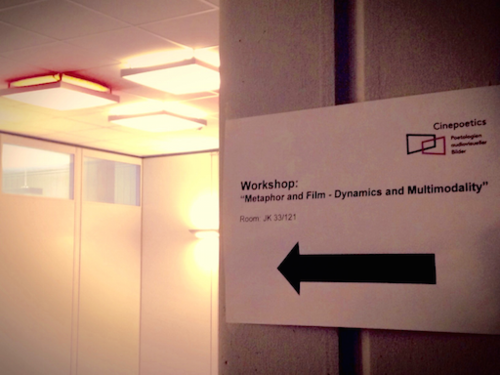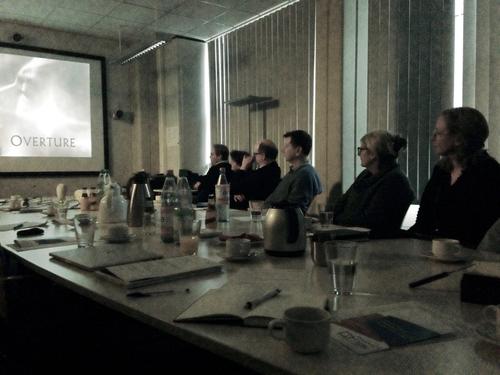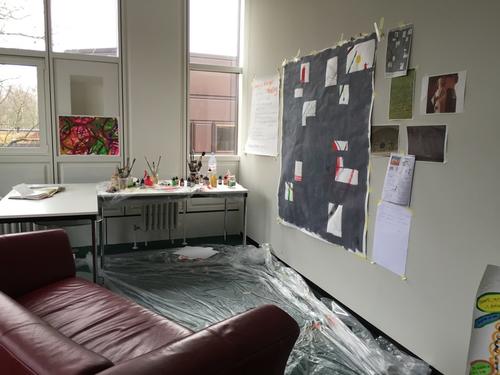Metaphor and Film: Dynamics and Multimodality
07. – 12.01.2016 | Workshop by the Cinepoetics group with Cornelia Müller (Frankfurt/O.), Lynne Cameron (London), Alan Cienki (Amsterdam), Irene Mittelberg (Aachen), Warren Buckland (Oxford), Oliver Lubrich (Bern), Raymond Gibbs (Santa Cruz).
Within the context of the Center's first annual research topic Metaphor – Cognition and Film Thinking, the 4-day-event "Metaphor and Film: Dynamics and Multimodality" was a thematic workshop organised by and held at Cinepoetics.
Participants included renowned international scholars and metaphor experts, such as Raymond Gibbs Jr. (Professor of Psychology, University of California, Santa Cruz), Oliver Lubrich (Professor of German and Comparative Literature, University of Bern), film scholar Warren Buckland (Oxford Brookes University), Irene Mittelberg (Assistant Professor of Linguistics and Cognitive Semiotics, RWTH Aachen), as well as our current senior fellows, Cornelia Müller (Professor for Language Use and Multimodal Communication, European University Viadrina), Lynne Cameron (Artist and Professor for Applied Linguistics, Open University, London) and Alan Cienki (Professor for Language Use and Cognition, Vrije Universiteit Amsterdam).
Introduction and SPELLBOUND
Spellbound workshop participants (from left to right: Wedel, Eusterschulte, Buckland, Cienki, Cameron, Mittelberg)
After an introduction by Michael Wedel and Cornelia Müller to the Center and the workshop, the group attended a screening of Alfred Hitchcock's Spellbound. This established a common ground for the vivid discussions during the whole workshop and especially for the analytical presentation on the next day on "Emergent Metaphoricity in Hitchcock's Spellbound" by Cornelia Müller, Hermann Kappelhoff, and colleagues. With their talk on cinematic metaphoricity, they presented an investigation of the filmic medium's inherent temporality and multimodality of metaphorical structures. Following their approach, in which Film Studies intertwines with research coming from the field of Applied Linguistics, metaphoric meaning emerges from the interplay of various expressive modalities, that is, affective-expressive phenomena that could be classified as acts of performance and acts of perceiving. Building on Lynne Cameron’s concept of "systematic metaphors", they explored Spellbound as a dynamic orchestration of expressive movements constitutive for cinematic metaphoricity. This includes forms of affect modulation as meaning-making which, in the sense of Vivian Sobchack's neo-phenomenological film theory, are intimately tied to the bodily experience of the viewer. Consequently, the goal was not to provide a tautological reading of Hitchcock's film but rather to inquire the interrelation between meaning-making and affective experience over the course of time.
Cameron: Wanderings in the Umwelt
In her subsequent presentation, "Wanderings in the Umwelt. Metaphor Poiesis in the Art and Talk", Lynne Cameron focused on two realms of experience of metaphor temporality. With regard to her work as a linguist she began with a section on "temporality and verbal metaphor and talk", before turning to her work as an artist by presenting further thoughts on "temporality and the emergent poetic". She presented verbal data from a transcribed conversation of Jo Berry, the daughter of an IRA victim, and Pat Magee, the IRA bomber who killed Berry's father. The presentation of this exceptional material also involved a hands-on analysis for the participants of the workshop. Though exclusively focussing on verbal data, Cameron's account of metaphors in language use which is grounded in the dynamic system theory proved to be instructive for the workshop's focus, since it offers a highly dynamic understanding of metaphor in use.
Following up on this, Cameron turned to her stay as artist-in-residence at Cinepoetics, where she focuses on "voyages of discovery and re-discovery" and regularly invites the members of the Center to her studio for talking about art and art making. Cameron reconstructed a very own and experimental experience of poiesis, (i.e. a "bringing-into-the-world" of something that has not existed before) unfolding during her stay at Cinepoetics. Based upon pictures she took on a Berlin city walk, Cameron made various pencil drawings that she then further developed in collaboration with members of the Center, experimenting with certain image compositions, framings, and fragments of poems.
Cameron then further exemplified her thoughts on "the emergent poetic" with two poets, Seamus Heaney and Mark Doty, and their reflections on their own work process. Here she drew a connection to the term "Umwelt" (in its semiotic sense) describing the world as it is subjectively experienced, as something connecting the exterior and the interior, full of latent potential for metaphors, art, and poetry.
"Double Vision": An Excursion to the Museum
On the weekend the participants found time for a group activity in the city center of Berlin. The exhibition "Double Vision: Albrecht Dürer & William Kentridge" at the Kupferstichkabinett offered a wide range of interesting topics to enrich the discussions of the workshop even more. Lead by Lynne Cameron, the group roamed through seven differently themed rooms in which the works of German Renaissance printmaker Dürer clashed with those of contemporary multi-media artist Kentridge. While the latter impressed the group with a series of prints as well as refined stop-motion works, Dürer's famous woodcuts "Melencolia I" and "Rhinocerus" were to be admired. In the subsequent discussion about the exhibit the group gathered their thoughts on the question as to how a worthwhile connection between scholarly and artistic activity can be established.
From "Metaphor in Speech and Gesture" to "Metaphor in TV News"
In his presentation, the gesture researcher and cognitive linguist Alan Cienki provided an overview of different approaches to metaphors within the context of linguistics—from theories on amodal symbols (Chomsky) to the concept of metaphoricity as a mapping process (Lakoff & Johnson) which designates the transition from a source domain to a target domain.
Moreover, Cienki traced this operation of mapping back to its mathematical origin. He then turned to most recent linguistic research introducing the work of David McNeill, Geneviève Calbris, Cornelia Müller and himself to elaborate on the interrelations between verbal expression and bodily gestures in everyday communication, which were discussed in terms of their relevance for the analysis of cinematic metaphors and expressive movements. Cienki also touched upon the idea of "referential gestures" (and their shortcomings) as well as on the concepts of "blending" (Fauconnier/Turner) and "mental simulations" (Barsalou).
Using the example of two German television news reports (one taken from the popular news format “Tagesschau” and the other from “Report Mainz”, a political magazine programme) Cornelia Müller, Christina Schmitt, and Thomas Scherer went into more detail about their theoretical and analytical work on metaphors and audiovisual configurations. They could demonstrate that non-fictional forms (such as news reports), too, operate with multimodal dynamics of meaning-making which are grounded in modes of bodily experience.
The interplay of speech, gestures, movement patterns, etc. is not necessarily tied to the emergence of meaning as it is expressed in face-to-face communication; rather, this interplay can produce dichotomies and contradictions—a potential for forms of irony, sarcasm, and exaggeration underlining the fundamental correlation between affect and meaning within the dynamic unfolding of metaphors.




